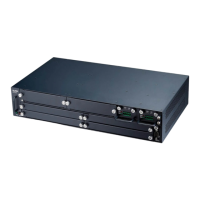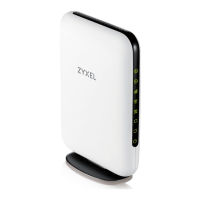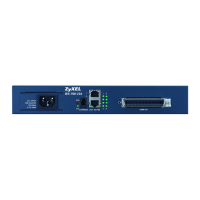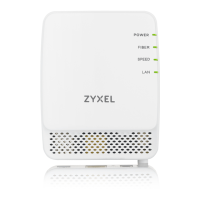Chapter 21 Classifier
OLT2406 User’s Guide
176
VLAN Select Any to classify traffic from any VLAN or select the second option and specify the source VLAN
ID in the field provided.
Priority Select Any to classify traffic from any priority level or select the second option and specify a priority
level in the field provided.
Ethernet
Type
Select an Ethernet type or select Others and enter the Ethernet type number in hexadecimal value.
Refer to Table 59 on page 177 for information.
Source
MAC
Address
Select Any to apply the rule to all MAC addresses.
To specify a source, select MAC to enter the source MAC address of the packet in valid MAC address
format (six hexadecimal character pairs).
Port Type the port number to which the rule should be applied. You may choose one port only or all ports
(Any).
Destination
MAC
Address
Select Any to apply the rule to all MAC addresses.
To specify a destination, select MAC to enter the destination MAC address of the packet in valid MAC
address format (six hexadecimal character pairs).
Port Type the port number to which the rule should be applied. You may choose one port only or all ports
(Any).
Layer 3
Specify the fields below to configure a layer 3 classifier.
DSCP Select Any to classify traffic from any DSCP or select the second option and specify a DSCP (DiffServ
Code Point) number between 0 and 63 in the field provided.
IP Protocol Select an IPv4 protocol type or select Others and enter the protocol number in decimal value. Refer
to Table 60 on page 178 for more information.
You may select Establish Only for TCP protocol type. This means that the OLT will pick out the packets
that are sent to establish TCP connections.
Source
IP
Address/
Address
Prefix
Enter a source IP address in dotted decimal notation.
Specify the address prefix by entering the number of ones in the subnet mask.
A subnet mask can be represented in a 32-bit notation. For example, the subnet mask “255.255.255.0”
can be represented as “11111111.11111111.11111111.00000000”, and counting up the number of
ones in this case results in 24.
Socket
Number
Note: You must select either UDP or TCP in the IP Protocol field before you configure the
socket numbers.
Select Any to apply the rule to all TCP/UDP protocol port numbers or select the second option and
enter a TCP/UDP protocol port number. Refer to Table 61 on page 178 for more information.
Destination
IP
Address/
Address
Prefix
Enter a destination IP address in dotted decimal notation.
Specify the address prefix by entering the number of ones in the subnet mask.
Table 57 Advanced Application > Classifier (continued)
LABEL DESCRIPTION

